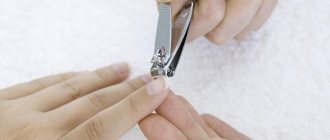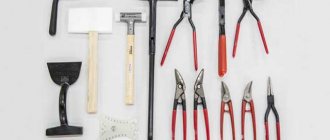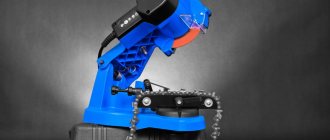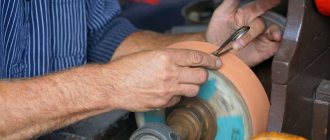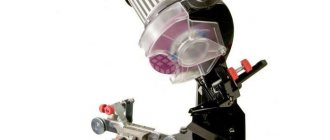Choosing and purchasing a manicure tool is only half the battle, since it requires constant and high-quality maintenance and sharpening. New scissors or forceps can become dull after just a few uses, and some need to be brought into good working condition immediately after purchase. It all depends on the quality of the metal and the initial characteristics of the tool. What does a manicurist need to know about sharpening manicure tools? Is it possible and how to sharpen nail scissors, tongs and cutters at home? How to evaluate and accept a job in the service? Let's look at all the questions in order.
Rules of care
For manicure accessories to last a long time, they need to be well cared for. It is very important to store your tools correctly. Most often, they become unusable precisely because of improper storage.
Regular and timely care of manicure accessories will ensure their comfortable use and long service life.
- Scissors, wire cutters and tweezers must be stored in special cases , otherwise notches and unevenness may form on their surface. If you don't have a special case, you can wrap them in soft cloth.
- Do not store manicure accessories next to each other , avoid sudden temperature changes and high humidity.
- Place all cutting tools with the blade facing up or on its side .
- Scissors and wire cutters should be oiled .
Signs of a dull instrument
Typically, a blunt tool has jagged edges; sometimes of scissors and wire cutters differ The tips and cutting edges become so thick that it is almost impossible to grip the skin or remove an ingrown toenail.
The frequency of sharpening depends on how often you use the manicure set. Usually the need for it occurs once every 2-6 months .
This video will tell you how to sharpen nail clippers:
Signs of a well-sharpened tool
- Cuts the nail plate, rough skin and cuticle smoothly, with the entire blade, but especially well at the tips.
- Cuts in a thin layer.
- Causes deep deformations.
- Does not tear or pull the skin.
- It runs smoothly and cuts well without pressure.
Appearance of a well-sharpened tool
- The working blades are free from nicks, scratches and stains;
- the tips of the scissors and nippers are thin and equal in length and width;
- the cutting blade is uniform and has no sharp breaks;
- when closed, the cutting blades do not intersect.
Checking the sharpness
Professional craftsmen have their own proven methods for determining the sharpness of a tool required for a job, but there are universal methods that absolutely everyone can use. So, sharpening cuticle cuticle nippers is necessary if the tool cannot cut polyethylene thinly, evenly and without effort. After such an experiment, the presence of torn sections indicates similar trauma to the skin during work, so such tweezers should not be used.
In addition, the complete serviceability of the nippers is indicated by the absence of clicks during operation, the tight fit of the cutting blades in the area of the nose, with light pressure and strong compression, as well as the smoothness of movement.
The sharpness of nail clippers is checked by cutting the electrical tape. The cuts must also be smooth, the cutting blades meet tightly along the entire length, and when pressed, a characteristic click is felt.
The sharpness of manicure scissors for cuticles and nails is checked by similarly cutting polyethylene or electrical tape. A scraper is an equally important tool in the set - when working with a nail, it should slide along its surface without catching the top layer.
Sharpening accessories
Diamond sharpening wheel
You can sharpen manicure accessories in a special workshop or yourself. To do this, you can use a regular fine-grained whetstone or machine . It is advisable to use a diamond-coated grinding wheel . You can buy it at any hardware store or rent it.
You can also use sandpaper . This option will provide a softer and faster sharpening, and it is much simpler than the others. However, such sharpening is short-lived and requires more frequent repetition.
If scissors have curved blades, it is almost impossible to sharpen them yourself. You can only tighten the connecting bolt, and it is better to entrust sharpening to professionals.
To sharpen efficiently, you can take special courses or master classes. It is also advisable to undergo training if you often use manicure tools and they require constant care and sharpening.
Best models
The rating is based on popularity among buyers.
Diold MZS-02
The model is intended for domestic use. The machine is multifunctional, designed for sharpening drills with a diameter of 3-13 mm, knives, scissors and axes with a narrow blade. The compact device operates from an electrical network with a voltage of 220 W.
The machine body is equipped with protective glass to prevent the spraying of metal dust during operation of the equipment. The period of non-stop operation is 15 minutes. After this, the equipment requires a 5-minute rest.
The machine has increased electrical safety, which is ensured by double insulation. Operating temperature range from -15 to +35°C. Sharpening of cutting surfaces is carried out using grinding wheels. They have a non-standard shape, so they cannot always be found on sale.
Advantages:
- several operating speeds;
- multifunctionality;
- compactness;
- light weight;
- ease of operation.
- The main disadvantage is the high noise level during operation.
VORTEX SZM-65
The universal model is designed for sharpening drills with a diameter of 3-10 mm, chisels with a blade width of 6-51 mm, knives and scissors. Sharpening of cutting surfaces is carried out with a grinding wheel having a diameter of 49.3 mm and a thickness of 7 mm. It is provided for cooling during operation.
The compact device weighs 2 kg. It is convenient to install on workbenches. The base of the machine has holes for attachment to various surfaces. A protective screen is installed on the body. The device operates from an electrical network with a voltage of 220 W.
Advantages:
- good power;
- compactness;
- ease of operation;
- low cost;
- high quality sharpening of cutting surfaces.
- The main drawback is the lack of illumination of the working surface.
Sturm BG6010S
Universal machine. The model has an inclined platform with precise adjustment of the sharpening angle of the cutting surfaces. The device can sharpen drills with a diameter of up to 10 m, chisels, knives and scissors. They are securely attached to the housing during operation with special clamps and magnetic latches.
Sharpening of the cutting tool is carried out with a small circle mounted on the spindle of the electric motor. The weight of the device is 2 kg. The machine operates from a power supply with a voltage of 220 W. Minimum permissible operating temperature is +5°C. The machine is manufactured in China, but is a German design.
Advantages:
- light weight;
- compactness;
- versatility;
- reliability;
- ease of operation.
Flaws:
- low power;
- It is difficult to find sharpening wheels for sale.
PATRIOT BG 100
The multifunctional machine is intended for household use. The model operates from an electrical network with a voltage of 220 W. The device can sharpen knives, scissors and other cutting tools with a narrow blade. It can sharpen drills with a diameter from 3 to 13 mm.
Machine weight 1.1 kg. Its compact dimensions allow it to be installed on a workbench in a small workshop or garage. The base of the device has holes for mounting. The machine has simple controls and conceptual settings that anyone can handle. There is a protective screen on the case. Grinding disc diameter 51 mm, thickness 8 mm.
Advantages:
- light weight;
- compactness;
- versatility;
- low cost.
Flaws:
- low power;
- not intended for intensive work.
BISON ZTSHM-150 686L
Machine for sharpening and grinding. Sharpening of cutting surfaces is done using a grinding wheel, and grinding with an abrasive belt. The model has a durable design and is intended for semi-professional use. There is a protective screen on the case. Machine weight 7.7 kg.
Sharpening of cutting surfaces on a machine can be done in two stages. First on a coarse abrasive, and then on a fine-grained one. The device switch is protected from dust. The bed rests on rubber feet, which prevent it from sliding on any type of surface. The device operates from an electrical network with a voltage of 220 W.
Advantages:
- reliable design;
- multifunctionality;
- high performance.
Flaws:
- heats up quickly during operation;
- strong vibration.
Kolner KBG 150F
Multifunctional machine with engraver. The model is designed to perform a wide range of work: sharpening, grinding, engraving, etc. On the front panel of the case there is a convenient control for setting the type of work. The machine body has a protective screen.
The machine has 2 grinding wheels: abrasive and flexible. The device operates from an electrical network with a voltage of 220 W. During operation, it must be turned off periodically to prevent the engine from overheating. Machine weight 2 kg.
Advantages:
- multifunctionality;
- low cost;
- light weight;
- compactness.
Flaws:
- there is curvature in the fit of the grinding discs;
- The discs brake when pressed hard.
Wester TSL170B
The machine is designed for sharpening cutting tools, including knives and scissors. Two grinding wheels are installed on the body, having working surfaces with different degrees of abrasive grain size. This allows you to do rough and finishing processing of the cutting surface on one machine.
There is a protective screen on the case. The device operates from an electrical network with a voltage of 220 W. The frame has holes for mounting the machine on a workbench. The weight of the structure is 3.8 kg. The start and shutdown button is protected from dust, moisture and dirt by a silicone pad.
Advantages:
- light weight;
- compactness;
- multifunctionality;
- low cost.
Flaws:
- small persistent platform;
- Not enough power to sharpen garden tools.
JET JSSG-10
The machine is designed for sharpening important cutting tools: chisels, wood cutters, scissors, knives, etc. One of them is equipped with a leather casing, which is intended for polishing. There are two grinding wheels installed on the common shaft of the structure. The machine does not overheat during operation. There is a protective screen on the case.
On the adjustable steel guide there is a bracket for attaching special devices. They help maintain the required sharpening angle of the tools being processed. To make it easier to carry the machine, there is a handle on its body. Machine weight 19 kg.
Advantages:
- the shaft bearings are protected from dust, dirt and moisture;
- there is a reservoir for wetting the abrasive disc;
- presence of a drawer for accessories.
Flaws:
- during operation, water spreads over the blade of the tool being sharpened in all directions;
- After use, the machine must be dried.
Interskol T-150/150
The machine is designed for sharpening cutting tools, including scissors, at home. The design is equipped with two sharpening abrasive discs of different grain sizes, which can be used for rough and finishing processing of cutting surfaces, as well as wood and metal.
Protective screens are installed on the body. There is illumination of the working area and stops for the tool being processed. The operating period without stopping is 30 minutes. The device operates from an electrical network with a voltage of 220 W. Machine weight – 5.9 kg.
Advantages:
- low cost;
- good sharpening quality;
- safety;
- reliability;
- compactness.
Flaws:
- increased level of vibration during operation;
- The backlight light is not strong enough.
PIT PMTS1003-C
The machine is designed for sharpening cutting tools, including scissors. The powerful engine and high performance of the model allows it to be used for work in workshops. A protective screen is installed on the body. The device operates from an electrical network with a voltage of 220 W. The weight of the machine is 1.65 kg.
Advantages:
- light weight;
- multifunctionality;
- compactness;
- good sharpening quality;
- high performance;
- low cost.
- No deficiencies identified.
Types of sharpening
There are different types of sharpening: mechanical and diamond, manual and professional.
Diamond
During factory diamond sharpening, parameters such as sharpness, ideal angles, and convergence of cutting edges are taken into account. This technology allows you to sharpen products that have denser metal in the cutting part, making them more durable and sharp. This sharpening can last for more than a year in home use.
Mechanical
Mechanical sharpening is carried out using mechanical machines. In this case, the master processes each tool manually, giving the necessary sharpening angles, controlling the entire process exclusively by hand. This type of sharpening is simpler and less durable.
Get acquainted with the author's sharpening technology:
Methods
A good craftsman can be identified not only by the work performed, but also by the condition of the tools, namely by sharpening. After all, a sharpened tool allows the master to perform his work efficiently and reduces the risk of injuring the client to a minimum. There are two ways to sharpen tools: give them to a professional or sharpen them yourself. Sometimes it is not possible to turn to a professional sharpener due to lack of time, trust or funds, since the procedure is not the cheapest. In this case, you can try sharpening your tools at home.
How to prepare manicure tools for repair
Before you sharpen a manicure tool, you need to make sure that the problem is in the sharpening and prepare it properly.
Carefully inspect the tool for the presence of center play in the scissors; the axle mount may have become loose. Typically, the axle is a screw or rivet. If a bolt is used, tighten it.
If the screw is already tightened and the blades are still hanging loose, do not bend the blades under any circumstances. This can be corrected by sharpening the limiter, this will allow the blades to be brought closer to each other. Even new cutters sometimes have some play initially. If it is not removed, there will be no correct pressure on the cutting edges, as a result of which the nippers will leave burrs and make poor cuts.
Sharpening at home
Having everything you need, you can sharpen your tools yourself. To do this you need a sharpening stone, sandpaper, and lint-free wipes .
Place the sharpening stone on a flat surface, open the nail scissors or tongs wide and begin sharpening. Movements should be smooth, even, and there is no need to sharpen for a long time. After completing the procedure, the instrument should be wiped with a soft cloth.
The sharpness is checked on a piece of polyethylene: if the tool is well sharpened, the polyethylene should not wrinkle when cut.
It is best to have a sharpening machine with a diamond wheel, which will make your task much easier and keep the tool sharp much longer than sharpening on paper or a whetstone. But such an expensive purchase is only advisable if you do manicure professionally.
How else to sharpen scissors: “improvised” solutions
Do you need to quickly sharpen scissors at home, but don’t have special tools? Available means that can be found in any apartment will do. With their help, sharpening can be done in a matter of minutes. True, the result will be short-lived, but it will be possible to cut “here and now.”
It is better not to experiment with home sharpening methods that involve the use of improvised means if you value the product. For example, professional tools should not be sharpened this way - you can ruin them forever.
Sandpaper
Peculiarities. This method is suitable if the product has only slightly lost its sharpness. This method will not save a very blunt instrument.
How to sharpen
- Fold a sheet of fine-grit sandpaper so that the abrasive side is on top.
- Cut the paper into long strips so that the entire length of the blade is used.
- Make about 20 cutting movements.
- Wipe the blade to remove any sandpaper chips.
- Check the sharpness - the result will surprise you.
Sandpaper will help if you need to sharpen zigzag scissors with your own hands. This tool is distinguished by a characteristic blade edge, so sharpening it with a bar is difficult.
Foil
Peculiarities. If you need maximum sharpness, cut many thin strips. When you just need to sharpen a tool, it will be enough to make a couple or three wide strips.
How to sharpen
- You will need a 25cm sheet of foil. Fold it lengthwise several times to create a fairly thick strip.
- Cut the material into strips.
- Make sure that the entire blade is used (base - tips).
If you urgently need sharp scissors, use one trick: the more layers you make by folding the foil sheet, the stronger the sharpening effect will be in one cut.
Metal sponge
Peculiarities. During sharpening, residues fly off from the sponge. There are many of them and they are small - it will be difficult to remove. Sharpen directly over the trash can so you don't have to clean up later.
How to sharpen
- Take a metal kitchen sponge. If you have a choice, it is better to take the one that is softer.
- Cut the sponge using the entire blade.
- The more cuts there are, the sharper the tool will become.
Gypsy needle
Peculiarities. This makes it convenient to sharpen small scissors, for example, for cuticles. At the same time, sharpen your nail clippers if necessary.
How to sharpen
- “Cut” the needle. When closing the blades, try to guide the needle along the cutting edges.
- Apply a minimum of force: cutting movements should be light.
- Continue cutting until the blade becomes sharp.
Instead of a needle, you can take a sewing pin, knitting needle or screwdriver. The main thing is that the essence of the method is not lost - you need to cut using metal.
Glass jar
Peculiarities. You need to use a jar that is not needed: it will later have scratches. If you need to sharpen a small item, it is better to use a bottle with a narrow neck.
How to sharpen
- “Cut” the jar: the blade should slide and the container should slide back.
- The cutting movements must be repeated until you are satisfied with the result.
- Wipe the blades; there may be glass dust on them that is not visible.
Remember that traditional sharpening methods are designed for immediate results. To keep the scissors “in shape”, you will have to return to the chosen method often. Or still take the products to the master.



